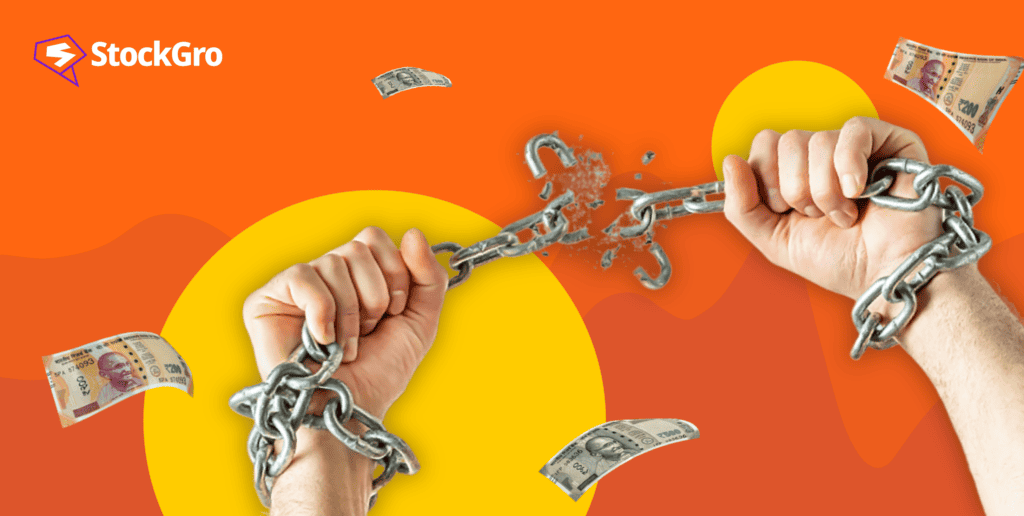
Nowadays, the word “financial freedom” pops up often. However, the concept of financial freedom may differ from one another. Some believe it’s about being debt-free, purchasing what you’d like whenever you want, or just being wealthy.
So, what does it mean? We at Stockgro believe that everyone’s path to financial independence is unique. The steps to achieving financial freedom may differ according to your personality, lifestyle, and current and future goals.
In today’s article, we will look at how to become financially free in a step-by-step manner, starting with the basics of the concept. So, if you search for the meaning of financially independent often, this article is for you!
Also read: What is personal finance, and why is it important?
What is financial freedom?
To each individual, freedom has a unique meaning. Your current stage in life, place of residence, habits, and goals are just a few of the many factors that will determine this. If we go by the definition, financial freedom means paying all of one’s living expenses out of one’s remaining cash flow without worrying about your bills or any unexpected expense.
Having a comfortable financial situation is more important than earning a lot of money; what matters is having enough to satisfy your basic requirements and free up time to pursue your interests rather than grind out a living. And careful planning can do the trick easily.
Here are some factors to keep in mind when you start thinking about your financial independence:
- Having a steady source of income and being financially independent
- Having a solid plan to reach your financial objectives
- Being financially prepared in the event of an emergency
- Being financially secure enough to live the way you want
All of these translate into a broad sense of security and financial well-being.
How to become financially independent?
Here is a rundown of some factors to think about if you want to achieve financial independence:
- Understand where you’re at with a positive outlook on money
Finding out where you are financially is the first step towards becoming financially free. This step involves being well-informed about your financial situation, including your total debt, savings, monthly costs, income, etc.
Put simply, you should be familiar with your financial statement and have a solid understanding of your income, spending, assets, and responsibilities.
Be sure to include any loans you have taken out, such as mortgages, educational loans, car loans, credit card balances, etc. Don’t even leave out the loans you may have taken from family or friends.
Looking at your savings is the next step. Everything from your savings to your monthly income to your investments could fall into this category.
Since we are talking about the basics, many people have another problem when they try to make money: they believe having money is evil. Think of money as a tool, not an obstacle, if you want to be financially free.
Why? Because your odds of attracting and maintaining financial success will significantly reduce if you have a negative outlook on wealth.
Also read: Insurance 101: How to protect yourself and your assets!
- Track your spending and make a monthly budget
Keeping track of your spending is the next important step towards being financially free. An Excel worksheet or a notebook are just two of the many ways you can do this. You become more accountable when you monitor your spending, which is crucial to financial independence. In addition, it shows how often you spend cash due to impulse buying.
Your best bet for ensuring all your bills are paid and your savings are on track is to make a monthly budget and stick to it. The 50/30/20 rule is a simple framework for budgeting—or a spending plan.
In this budgeting strategy, you allocate 50 per cent of your post-tax income towards necessities (such as rent and bills), 30 per cent towards wants (such as going out and leisure), and 20 per cent towards savings, investing and paying off debts.
- Slash debt and spend less
Cutting costs doesn’t mean giving up everything you love or living a minimalist lifestyle. The key to financial independence is rather careful spending.
Apart from that, paying off your debts is equally important. In multiple ways, getting rid of debt helps you become financially free. Ultimately, you will have greater cash flow available to you in the future and a good credit score.
You may pay off your debt in two primary ways. As a first option, you may use the snowball effect to pay off your lowest debt first. This means you should focus on getting this smaller debt paid before moving on to the larger ones.
Second, you may use the avalanche strategy, which entails paying off the highest-interest debts first and eventually the lower-interest ones.
Also read: The role of compound interest to reach your financial goals
- Create an emergency fund and invest in your future
An emergency fund cushions against unknown costs, such as car repairs, sudden medical bills, or the loss of one’s job. While exactly how much you’ll need to save for an emergency depends on your financial status, a good rule of thumb is to save enough to cover all your expenses for a period of three to six months.
You may start small by setting aside a small amount of money in a high-yield savings account with each paycheck for an emergency fund.
The next step is to put as much money as possible into your investments as soon as possible so that the compounding effect can work for you. Eventually, try aiming to grow your assets at a rate greater than your income growth.
Try to have a 50–60% asset mix in stocks as early as possible. An asset mix divides your money among investments, such as stocks, bonds, cash, etc. Stocks are risky but rewarding, while non-equity assets are safer but less profitable. However, you can adjust the allocation to suit your risk level.
The next practical step is to invest automatically via SIPs; this way, you won’t have to worry about the market’s timing yet have a healthy and profitable portfolio. Apart from that, also make sure to adjust your portfolio and assess it once a year.
Lastly, don’t forget to keep yourself updated on financial literacy and best practices by reading books, blogs, or any other resources available that suit your financial goals.
Thumb rules to be financially free
Here are some simple but effective thumb rules suggested by experts in the field. Applying these in daily life is the first step towards financial freedom.
Saving
As a practice, people usually spend their income and save the rest. The change needs to begin from this. Saving should take priority over spending. Once you earn your salary or any other income, set aside a certain percentage of it for saving. Consider saving as ‘spending on yourself for a secure future and to be financially free’.
The obvious question here is, how much should you save? Well, there is no single number that works well for every individual. 50:30:20 is a general thumb rule that suggests spending 50% on needs, 30% on wants and 20% on savings. The 20% savings can be increased further based on one’s needs and wants.
Insurance
Insurance is often ignored because most people have it covered by the employer as one of the benefits. But what if you lose your job? What about insurance post-retirement?
The importance of insurance is well known. It helps people manage finances during unexpected events and crises. The absence of insurance exerts undue financial pressure, forcing individuals to rely on options like debt, which will take them far away from financial freedom. So, owning an insurance policy privately is crucial.
Coming to the size of the policy, the amount of insurance again varies from one individual to another. Annual income, liabilities, age, and health status of family members are some of the many factors that play a role in deciding the policy amount.
A general thumb rule suggests having an insurance policy that is 10 to 15 times one’s annual income. But, it is essential to remember that a larger coverage will require a higher premium payment. So, the capacity to bear monthly premiums must be ascertained here.
Loans
Should you buy assets like houses, vehicles, etc., on loan? Well, the debate is never-ending. This has two schools of thought – Some people are focused on assets over loans, while others focus on staying away from debts, even if it requires them to compromise on their desires.
The first step here is to understand where you stand among the two. If you are a minimalist, you may want to stay away from such assets that push you into debt. But, if you are ambitious and want to make good assets for yourself, debt may be an option for you. However, the important question is, how much debt should you borrow?
Falling into a debt trap to buy assets may not be very wise from the perspective of achieving financial freedom. The general thumb rule here is, that the combined EMI of all your loans together should be less than 50% of your income. One smart way to manage loans is to clear one loan before taking another, to avoid multiple financial commitments.
Retirement
Have you noticed that most people fear retirement? Instead of enjoying their freedom from work, people are mostly worried about how they will manage their financial commitments. This is due to a lack of financial planning from a young age.
Those who plan for their retirement at the start of their career can focus on living their retirement life peacefully, doing the things they love, rather than feeling worried and embarrassed to depend on their children.
A simple step towards retirement planning is to create a retirement fund and set aside 10% of your income from the first month of your career. You will not only have enough savings but can also benefit from the power of compounding.
A thumb rule to follow post-retirement is not to withdraw more than 4% of the fund per annum. With this, you will have enough in your account to sustain for the rest of your life.
Conclusion
In essence, getting financial independence requires understanding your current financial situation, budgeting wisely, paying off debt, building savings, and investing for the future. Following these basic yet crucial steps helps create a sense of security and freedom to live on your terms.
